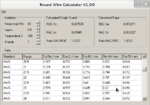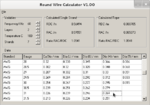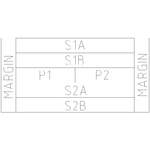ALERTLINKS
Advanced Member level 4
Temporarily short the inductor and observe if the output voltage increase.
Follow along with the video below to see how to install our site as a web app on your home screen.
Note: This feature may not be available in some browsers.
i am wondering " that 181vdc at the input of the inverter generating only 20vac .
To diagnose this , first you make sure that the DC DC stage is working fine or not, so you can easily connect the 20 watt bulb and check the output voltage of DC DC stage , it should be 180vdc .
I think the reason of getting only 20v AC is dc bus ( 180V).it will no longer be 180V at 20V AC output.so,before going to the next stages you have to improve your dc-dc converter.
No it drops to 171Vdc with the 20W bulb but I assumed this was ok as the bulb is a resistive load hence there will be voltage drop. Also, the transformer no longer drops the voltage I think it was because I left out a air wire connect two grounds.
- - - Updated - - -
I checked the voltage while it is connected to h-bridge and I get 180Vdc just the same. when I test inverter with 12Vdc as the dc bus I get about 12VAC and when I vary the supply the ac output increases which is expected and so I am quite confused as to why with 180Vdc I am not getting over 100 VAC.

Would you consider doing something 'completely different', that is likely to involve more pain and will similarly be doomed to failure?
At the moment you are using a push-pull converter to generate a DC output bus for your full bridge and then using PWM, via a micro-controller, to gain some semblance of a sine wave.
Let's walk back to the battery.
Your push-pull converter is in effect a buck converter and as such it's input current, as drawn from the battery and assuming you do wish to achieve regulation rather than just putting power through the transformer, is discontinuous.
For example if you want 240W out from 12V in and your Push-Pull regulates at 80% duty cycle, 40% on time per switch, then you end up with a 0A/25A pull from the battery at the operating frequency of your controller.
Wet finger in the air says the battery will not like that and as a result you will be forced to include some form of input filtering.. It's also the case that your circuit layout will not like it as well.
You do not want to run multi-amp switched currents about the place unless you are prepared to keep them tight and local and in this case it is going to be hard to do. Having said as much no doubt others have experienced 'success', in varying degrees.
What to do?
First guess might be to implement a current fed push-pull boost converter..
https://www.ti.com/lit/ds/symlink/uc3827-1.pdf
Given I was forced to sign up for TI marketing dross I assume they will love the reference. No doubt TI is looking forward to 'up sell' or looking for 'bright ideas'.
You might wish to hunt elsewhere on the site for some of the application notes.. Otherwise conceptually you end up with one of these,
View attachment 104497
Your push-pull converter is now being, current fed, from a boost converter. The filtering inductor has been moved to the primary side, no need for the output inductor on the secondary side, and more importantly it is now in series with the battery.
As a result the battery no longer gets hammered with high frequency square amp currents and, assuming you keep things tight elsewhere, the pain might become less.
Of course you have now transferred that discontinuous current to the secondary side of the transformer but filtering becomes easier.
More pain later. You really do not wish to follow my floater.
i am wondering " that 181vdc at the input of the inverter generating only 20vac .
To diagnose this , first you make sure that the DC DC stage is working fine or not, so you can easily connect the 20 watt bulb and check the output voltage of DC DC stage , it should be 180vdc .
I am not sure I understand. So you're saying that I have been building a buck converter but if that were the case I would be getting less voltage at the output however I am getting a much higher voltage at the output than the input which is characteristic of a boost converter. I understand why you say buck converter because the inductor is at the output but the VOUT doesn't show this so I'm confused.
- - - Updated - - -
BawA, ALERTLINKS or anyone else,
I am using the IRFZ44N MOsfet as the push pull and the datasheet says VGSth min=2V and max=4V so does that mean inorder to turn it fully on I should get more than 4V for VGS????
I just checked the VGS of the IRFZ44N and I get 0.36V for both lowside FETs with VDS=12V. Whats wrong here why am I getting such a small VGS??????????
PLease Help!!!!!!!!!!!!
If it would have been such a low value, there would have been no output, but you are getting 180V. You are not measuring it correctly. You can see 11V pulses with oscilloscope. You can observe 6V-8v with multilmeter depending on duty cycle because meter show only average.I get 0.36V for both lowside FETs with VDS=12V.
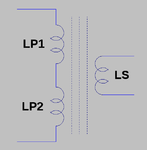

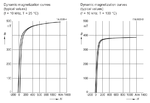

Yes.. Your output voltage is higher but that's because of the transformer. Topologically it is still a Buck configuration. If you were to normalise what is on the secondary back to the primary you would find that the 'output' voltage is in fact less than the input voltage.
If I remember correctly you have a turns ratio of 3:80 for 180V out 180*3/80 = 6.75.. less than the input.
OK.. Ignore my flight of fantasy. Let's go back to yours and put a bit of thought into it. It looks like you are basing your ideas on,
https://tahmidmc.blogspot.co.uk/2013/01/using-sg3525-pwm-controller-explanation.html
https://www.blogger.com/profile/09117804893438710050
I believe the man concerned is a member of these forums.
First off consider your transformer,
https://tahmidmc.blogspot.co.uk/2012/12/ferrite-transformer-turns-calculation.html
Your solution apparently uses an ETD34 core with three turns on the primaries. Here's a ferrite core databook.
https://www.epcos.com/blob/519704/download/2/ferrites-and-accessories-data-book-130501.pdf
Ignore all that for the moment.. Here's what your transformer looks like,
View attachment 104524
Those 'inductors' are real. The technical term for them is magnetising inductance. Individually your windings are in fact inductors. The core might serve to couple them together but nonetheless they behave like inductors.
Some sums.
L = Uo.Ue.N².Ae/Le
Uo permeability of free space.
Ue effective permeability of your core.
N number of turns.
Ae effective area of your core.
Le effective magnetic path length of your core.
B = Uo.Ue.N.I/Le
I is the current in the winding.
Bear in mind that these are SI units..
Re-arrange those..
Uo.Ue = N².Ae/L.Le
Uo.Ue = N.I/B.Le
Equate
N².Ae/L.Le = N.I/B.Le
Re-arrange and cancel some things
N = L.I/B.Ae
Now if you wanted to design an inductor of value L to carry a maximum current of Ipk with a maximum flux of Bpk then given the effective area of your core you can work out the minimum number of turns you require. It gets a bit more complicated in that you also have to consider winding losses. There is a sum that can be derived to give you a first cut as a guess...
For the moment we are looking at transformers. In particular for a Switch Mode Power Supply which in this case is imposing square wave voltages across the windings. As before realise that these windings are in fact inductors. If you apply a voltage across an inductor then the current through it ramps up over time.
I = Vin.T/L
In the transformer we say that the primary magnetising inductance is 'set' during the switch on time, Ton. I'll ignore 'reset' for the moment but just assume it goes back to zero during the switch off time. Peak current in the magnetising inductance is therefore..
Ipk = Vin.Ton/L
Re-writing the second to last one..
N = L.Ipk/Bpk.Ae
Re-arrange
Ipk = N.Bpk.Ae/L
Equating
Vin.Ton/L = N.Bpk.Ae/L
Re-arrange
N = Vin.Ton/Bpk.Ae
This lets you calculate the required number of primary turns to achieve a target value for Bpk. In your converter assuming you have set up the SG3525 to switch at 100KHz the maximum switch on time is 10uS.. 1/Fs. Your maximum input voltage is something like 13.4V for a lead acid battery.
View attachment 104519
For the ETD34 Ae is 97.1mm²
Ferrite comes in various flavours. For power conversion you will be looking to use things like N27/N87, other manufacturers will use different names. For the moment,
View attachment 104521
In terms of saturation they are much of a muchness and wet finger suggests you pick a Bpk of 300mT. Things are more complex because you have to consider core losses and you have the added {dis}advantage that your push-pull converter operates in both quadrants along with other possible problems.
For the moment we'll pick 300mT and put them all together to get
Np = 13.4*10E-6/0.3*97E-6
Np = 4.6
Round up to 5
Tahmid's equation is visually more complex since he uses f instead of Ton, 1/f, and he is using Gauss rather than the SI unit of Tesla for flux so there is an extra 'fiddle factor' involved.
https://tahmidmc.blogspot.co.uk/2012/12/ferrite-transformer-turns-calculation.html
There is one other problem with it but do not quote me on this one. I'm fairly sure that the form of his equation is actually used for low frequency mains transformers where the drive voltage is sinusoidal rather than being a square wave. Happy to be corrected though.
Back to the Ferrite data book
View attachment 104523
They quote Al values for ungapped cores. This is Specific Inductance Per Root Turn.. Previously,
L = Uo.Ue.N².Ae/Le
Al = Uo.Ue.Ae/Le
L = Al.N²
You can therefore calculate what your primary magnetising inductance is. In this case,
Lp = 2200E-9*5²
Lp = 55uH
Ipk = Vin.Ton/L
Ipk = 13.4*10E-6/55E-6
Ipk = 2.44A
The switches/windings and, battery, source have to carry this current in addition to the reflected secondary current.
That's enough for now.
Hopefully you can have a read through it and make sense of it. It is correct but things will by their nature become more complex. I do not know it all but magnetics design is a 'complex' subject and whilst there appear to be 'magic sums' available it is probable that you will find you have to 'iterate' towards a particular goal.
If SPWM is used, without LC-filter, output should be 20KHz pulse train modulated with 50Hz AC . It should deliver full current even with 12V supply. Use a car-12V bulb as load and see if it lights bright, FETs don't heat-up too much and there is no DC offset on either side.
Note that if a 12V pulse train of 50% duty cycle is observed with muti-meter, it will show averaged voltage i.e. near 6V. Peak voltage can be observed with an oscilloscope after calibration.
As output is AC, non-polar capacitor is required.
ok the ferrite core I am using is from Jameco electronics part #:2160665 it is not a ETD34 I just matched the specs and they have the same max power of 321W so I based the turns off the ETD34 since jameco did not give the Ac hich is the cross sectional area.


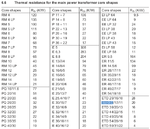
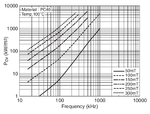

I am using the atmega32 so the carrier frequency is 8000Hz and the boot strap cap is a 47uF, 25V.Should I use the atmega16 instead with a switching frequency of 16000Hz??may be the bootstrap capacitor is not enough to keep the mosfet ON for entire 10ms duration . what is the carrier frequency of spwm and the value of bootstrap capacitor ?
It is later. Shopping done. Let's do sums.
Bear in mind that this is a methodology and you can vary it according to your own requirements and goals. I'm going to base this on convection cooling whereas the 'headline' figure suggests the manufacturers have chosen to give a figure for forced air cooling without providing further data. Forced air cooling is another layer of complexity...
From,
**broken link removed**
View attachment 104588
I guess one problem here is that they identify a measurement point but do not indicate whether it is a surface point or a point within the centre of the windings. Assume they have buried their thermocouple in the windings to get a 'worse case' figure.
You might use the graph directly to read numbers but you can convert what it is saying into a thermal resistance figure, Rth. 3W total dissipation gives you a 50°C rise which becomes roughly 17°C/W
For a quick 'reality check', assuming there is such a thing as reality in this game, the EPCOS{TDK} data book linked to previously gives a value of...
View attachment 104589
20°C/W Grumble grumble. They are not a 'million miles' out and just above the ETD34 value an ER35/20/11 is quoted at 18°C/W. We'll run with TDK's 17°C/W.
In the world of hard and fast rules as applied to magnetics design there are no hard and fast rules.. just starting points in order to move towards a solution. First one is you assign equal losses to the core and the windings. Pick an ambient temperature of 50°C and guess how hot you want your transformer to get.
The limiting factor in terms of temperature is likely to be the sort of inter winding insulation tape you will have access to or wish to use. Generally you will be using the 'yellow' polyester stuff with 'rubber' adhesive. I'll fail to go the extra mile and just say it is 'good' to 120°C operating temperature.
Given 50°C ambient and 120°C hotspot your permissible temperature rise is 70°C. Take the previous 17°C/W and 70/17 gives you a total, core plus winding, loss of 4.1W. Split that between core and windings and call it 2W core with 2W windings.
Given your core is, supposedly, PC40 ferrite then..
http://www.tdk.co.jp/tefe02/e16_1.pdf
View attachment 104580
I'm being 'Mr Dangerous' here and using the 100°C figures on the assumption that the core is in effect actually going to operate at a lower temperature than the windings given it is more exposed to the external environment and its insides will be more tightly 'coupled' to its outsides in order to move internal heat away.
You might wish to check what happens either side in terms of increased or decreased losses based on operating temperature.
The graph gives Pv as kW/m³
Elsewhere for your core,
**broken link removed**
View attachment 104583
The Effective Volume, Ve, of the core is given as 9720mm³ so there will be a bit of a 'conversion fiddle' that has to be applied.
Going for another 'reality check' as noted previously TDK claim 4.2W core loss when operating with a flux excursion of 200mT at 100KHz. Let's see how that one might work.
From the graph 200mT @ 100KHz gives about 400kW/m³. Take 9720mm³ and convert it to m³... 9720E-9 multiply and the result is 3.9W. The 'science' is not exact but once again it is in 'the ball park'. If you look back at the graph for core loss you will see my 'guess' of 400 was slightly low.
Turning things around our target is 2W core loss from 9720mm³ so dividing, 2/9720E-9 sticks us at a Pv of about 200kW/m³. Your transformer is working at a frequency of 50KHz so going back to the graph.. we end up being bounded between the 200mT and 250mT curves.
I have to admit to being a failure here because I have not worked out how to interpolate between lines on what appears to be a logarithmic dependency. However in order to wimp out I notice that 60KHz @ 200mT hits the 200kW/m³ spot.
This becomes your operating peak flux with a switching frequency, Fs, of 120KHz. Switch on time is , 1/Fs, 8.3uS. Bpk is 200mT. Effective area, Ae.. you refer to it as AC, is 107mm². Vin, possibly my mistake, is 13.4V
Npmin = Vin.Ton/Bpk.Ae
Npmin = 13.4.8.3E-6/200E-3.107E-6
Npmin = 5.2
Call it 5.
Things will fall to pieces later. They generally do.
may be the bootstrap capacitor is not enough to keep the mosfet ON for entire 10ms duration . what is the carrier frequency of spwm and the value of bootstrap capacitor ?
